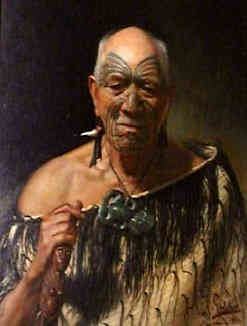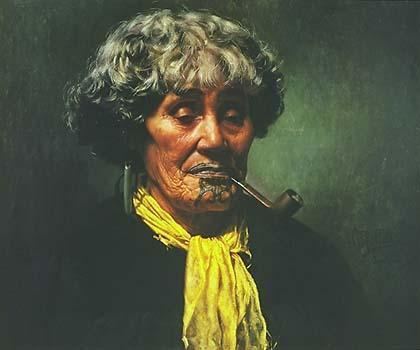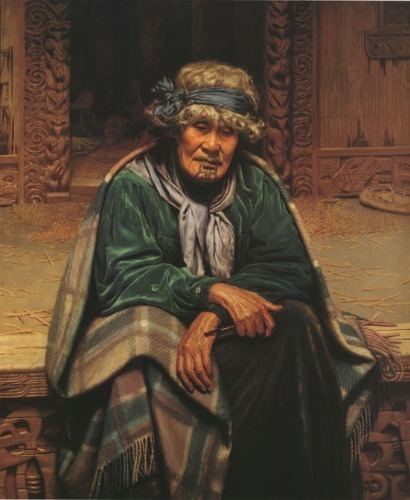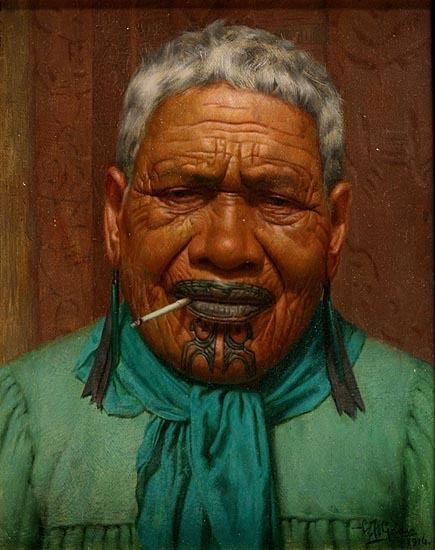Name C. Goldie Role Artist | Parents David Goldie | |
 | ||
Known for paintings of Maori dignitaries Died July 11, 1947, Auckland, New Zealand Artwork Ena te Papatahi, a Chieftainess of the Ngapuhi Tribe Education Auckland Grammar School, Academie Julian | ||
Douglas Lilburn, Aotearoa, C. F. Goldie, Petrus van der Velden
Charles Frederick Goldie (20 October 1870 – 11 July 1947) was a New Zealand artist, best known for his portrayal of Māori dignitaries.
Contents
- Douglas Lilburn Aotearoa C F Goldie Petrus van der Velden
- Early life
- Art education
- Artistic career
- Known sitters
- Honours
- Legacy
- Forgeries by Karl Sim
- References

Early life

Goldie was born in Auckland on 20 October 1870. He was named after his maternal grandfather, Charles Frederick Partington, who built the landmark Auckland windmill. His father, David Goldie, was a prominent timber merchant and politician, and a strict Primitive Methodist who resigned as Mayor of Auckland rather than toast the visiting Duke and Duchess of Cornwall and York with alcohol. His mother, Maria Partington, was an amateur artist and encouraged his artistic ability. Goldie was educated at Auckland Grammar School, and while still at school won several prizes from the Auckland Society of Arts and the New Zealand Art Students' Association.
Art education

Goldie studied art part-time under Louis John Steele, after leaving school to work in his father's business. A former Governor of New Zealand, Sir George Grey, was impressed by two of Goldie's still-life paintings that were being exhibited at the Auckland Academy of Art (Steele's art society, of which Goldie was honorary secretary) in 1891, and he talked David Goldie into permitting his son to undertake further art training abroad.

Goldie went to Paris to study at the famous Académie Julian. where Goldie received a strong grounding in drawing and painting.
Artistic career

He returned to New Zealand in 1898 and established the "French Academy of Art" with Louis J. Steele, who had been his tutor prior to his departure. They shared a studio and collaborated on the large painting The Arrival of the Māoris in New Zealand, based on Théodore Géricault's The Raft of the Medusa. It depicting exhausted, starved and stormtossed Polynesian mariners sighting land after a long journey by catamaran. It has been criticised as historically inaccurate (even in terms of contemporary anthropological knowledge) in its appearance of the crew and their vessel and in the situation of near-shipwreck depicted. However, it was widely praised at the time and is said to have launched Goldie's career.
Goldie and Steele parted ways not long afterwards and Goldie established his own studio, Steele apparently resenting the attention accorded to his former pupil. From 1901 he made field trips to meet, sketch and photograph Māori people in their own locations, and he also paid Māori visitors to Auckland to sit for him. Most of these were chiefs visiting the Native Land Court.
Steele trod a path established by Steele's Maori history paintings and portraits of tattooed chiefs. Also influential was his brother William, who in 1901 wrote an article that contradicted predictions of the demise of the Maori and later the journalist and historian James Cowan.
By far the majority of Goldie's subjects were elderly, tattooed Māori of considerable standing in their own society. (The practice of tattooing (Tā moko) was no longer current at the time, and the remaining examples were mostly elderly; it was also a practice largely confined to high-status individuals.)
Goldie dedicated his life to painting the Maori chiefs, Maori leaders and their communities who also became his friends. He lived with them on their various Maraes and spoke fluent Maori. He could have chosen to paint in many of the various popular styles of art at the time (having recently returned from Paris) but he believed that he had a gift and that was to dedicate his life to preserving the heritage of the Maori people whom he greatly admired. There are many critics of his work as it was so extraordinarily detailed. People thought that he used photographs frequently - he did not. He was highly trained and from a young age showed exceptional and undeniable talent, this is documented in his many prizes and awards throughout his lifetime. He was a gift to the Maori people and this continues to this day.
On 31 October 1920 Goldie traveled to Sydney, where on 18 November at the age of 50 he married 35-year-old Olive Ethelwyn Cooper, an Australian by birth but a resident of Auckland. They did not have any children.
Goldie's health eventually deteriorated through lead poisoning (from the lead white used to prepare his canvases). In order to create the finest of detail in his paintings, he would lick the end of his paint brush to ensure an even finer tip. This was a relatively common practice of the day and sadly led to his decline in health. He produced little work in the 1920s. Encouraged by the Governor-General, Lord Bledisloe, Goldie resumed painting around 1930; in 1934 and 1935 he exhibited at the Royal Academy of Arts in London, and in 1935, 1938 and 1939; the Salon of the Société des artistes français.
He stopped painting altogether in 1941 and died on 11 July 1947 aged 77.
Known sitters
Goldie was Auckland based and his subjects were mainly those from the tribes in the upper North Island.
Honours
In 1935, Goldie was awarded the King George V Silver Jubilee Medal. Soon after, he was appointed an Officer of the Order of the British Empire for services to art in New Zealand in the 1935 King's Birthday and Silver Jubilee Honours.
Legacy
Goldie's work held the Victorian attitudes he had grown up with that the Māori were a "dying race". However, many Māori value his images of their ancestors highly. On the rare occasions they are offered for sale they fetch high prices, among the highest for New Zealand paintings. People who know and understand the artist would never think to deny his place on a very high pedestal in New Zealand's artistic elite and the prices fetched reflect this view. In 2016 The International Art Gallery sold Goldie's last great artwork. The 1941 oil portrait of Wharekauri Tahuna was the first painting in New Zealand history to break the $1 million mark, finally reaching a top price of $1.175 Million. In March 2008, NZ$400,000 (NZ$454,000 including buyer's premium) was paid at an International Art Centre auction in Auckland for the painting "Hori Pokai - Sleep, 'tis a gentle thing. Earlier, NZ$530,000 ($589,625 including buyer's premium) was achieved for a Goldie work in an online auction conducted by Fisher Galleries. On 19 November 2010 opera diva Dame Kiri Te Kanawa sold the oil on canvas "Forty Winks", a portrait of Rutene Te Uamairangi for $573,000. This is the most paid for a painting at auction in New Zealand.
Many Goldies are held in public collections, including those at the Auckland Art Gallery, the Auckland Institute and Museum, and the Museum of New Zealand Te Papa Tongarewa. There is an ongoing controversy about the reproduction of Goldie's paintings of Māori that are held in public collections as prints for commercial sale.
Forgeries by Karl Sim
The convicted art forger Karl Sim changed his name legally to Carl Feodor Goldie in the 1980s in order to be able to "legitimately" sign his Goldie copies "C.F. Goldie". He no longer tries to pass them off as by the original C.F. Goldie, however. He published an autobiography with Tim Wilson in 2003 called Good as Goldie.
